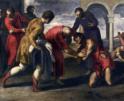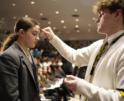
Culture
This Saturday, March 12, marks the 400th anniversary of maybe the most spectacular canonization of saints in the fascinating history of the Catholic Church.

Duncan
This Saturday, March 12, marks the 400th anniversary of maybe the most spectacular canonization of saints in the fascinating history of the Catholic Church. Pope Gregory XV proclaimed five people saints that day in St. Peter's Basilica, and they are among our greatest saints: Ignatius Loyola, founder of the Jesuits; Francis Xavier, the legendary Jesuit missionary; Teresa of Avila (big Teresa), the founder of the Discalced Carmelites; Isidore the Farmer, the 12th-century patron saint of Madrid; and the Florentine Philip Neri, founder of the Oratorians and 16th-century Apostle of Rome -- in an Italian wisecrack, "Four Spaniards and a Saint."
It was the first time that a number of individuals were proclaimed saints together, and also the first time that they had been beatified beforehand, a requirement recently imposed throughout the Church, along with the formal structuring of the Roman Curia, as part of the Catholic response to the Protestant Reformation. There were four men and one woman; or alternatively, four associated with ecclesiastical or religious orders (three of whom were founders of orders) and one layman; or four from the 16th-century Catholic reform and one from the 12th-century Middle Ages, depending on how one wishes to classify them.
Pope Francis, our one and only Jesuit pope to date, is scheduled to celebrate a 400th anniversary Mass at the Gesu in Rome on Saturday, the Jesuit mother Church where St. Ignatius lived, died, and is buried, and St. Francis Xavier's arm is exposed for veneration as a relic. It is scheduled for 5:00 p.m. Saturday Rome time (11 a.m. Eastern time) and can be live-streamed at www.ignatius500.global/live. The Vatican Post Office is also issuing a special aerogramme with a Baroque painting of the five saints for the 400th anniversary.
My personal favorite among the saints is St. Philip Neri. He also lies underneath a side-altar in another splendid Baroque church in Rome, Santa Maria in Vallicella, also known as Chiesa Nuova (it was "new" in the 16th century, before the Pilgrims landed at Plymouth). As one of his spiritual sons, John Henry Cardinal Newman, now also canonized a saint, said most eloquently, "He wished his children, individually and in private, to cultivate all their gifts to the full. He, however, was, after all and in all, their true model -- this humble priest, shrinking from every kind of dignity, or post, or office, and living the greater part of day and night in prayer, his room or upon his housetop." (He refused a cardinal's hat several times, saying that he preferred to go to heaven.)
"And when he died, a continued stream of people, says his biographer, came to see his body, during the two days that it remained in the church, kissing his bier, touching him with their rosaries or their rings, or taking away portions of his hair, or the flowers which were strewed over him; and, among the crowd, persons of every rank and condition were heard lamenting and extolling one who was so lowly, yet so great; who had been so variously endowed, and had been the pupil of so many masters; who had the breadth of view of St. Dominic, the poetry of St. Benedict, the wisdom of St. Ignatius, and all recommended by an unassuming grace and a winning tenderness which were his own."
In the Vatican Museums, there is a wonderful painting by Andrea Sacchi of the interior of the Oratorians' Church of Santa Maria in Vallicella elaborately decorated for the celebration of March 13, 1622, the day after the canonization, when the huge banner of St. Philip, which had decorated St. Peter's for the canonization and is still extant, was brought to his resting place. The amazing thing is that, apart from the banner and elaborate decoration, the Church looks the same today as it did then. May our own day and time see such a flourishing of holiness.
- Dwight G. Duncan is professor at UMass School of Law Dartmouth. He holds degrees in both civil and canon law.
Recent articles in the Culture & Events section
-
'Put no trust in princes'Greg Erlandson
-
The power of hopeMichael Reardon
-
Scripture Reflection for March 30, 2025, Fourth Sunday of LentDeacon Greg Kandra
-
The vibrant tapestry of the church in BostonWendy Mejia
-
Scripture Reflection for March 16, 2025, Second Sunday of LentDeacon Greg Kandra























